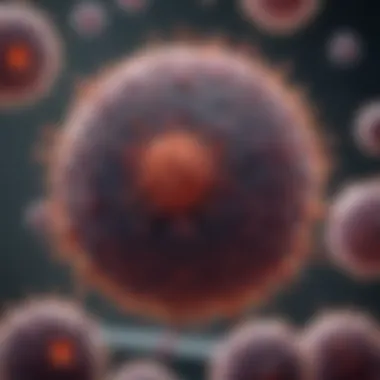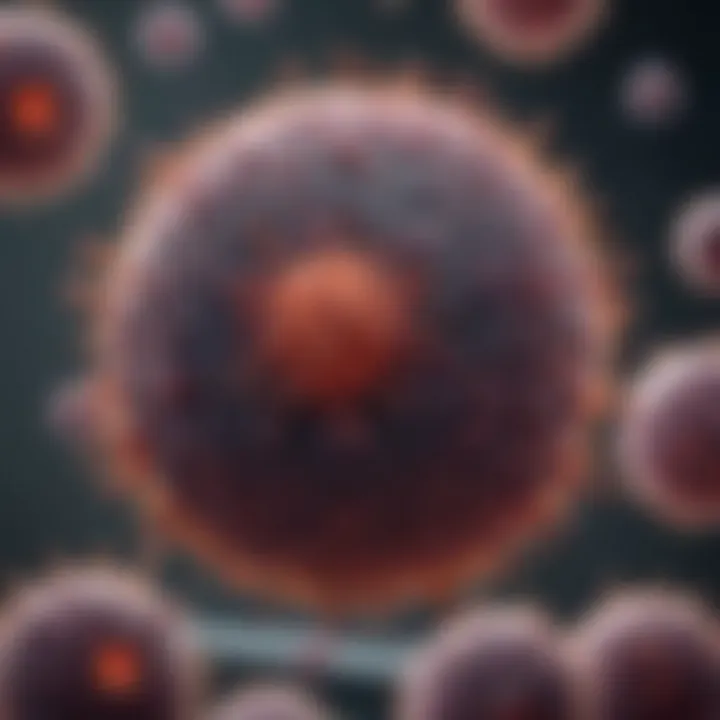Understanding Tumor Infiltrating Lymphocytes in Cancer


Overview of Research Topic
Brief Background and Context
Cancer immunology has come a long way, unearthing significant insights into how the immune system interacts with tumors. Tumor infiltrating lymphocytes, commonly referred to as TILs, are a focal point in this research. These lymphocytes, primarily T-cells that have penetrated tumor tissues, play a crucial role in the body’s response to cancer, making them vital to understanding how tumors evade immune detection. The discovery of TILs has sparked a renewed interest in utilizing the body’s immune response as a weapon against malignancies, propelling innovations in cancer therapies.
Importance in Current Scientific Landscape
The significance of TILs cannot be overstated. In an age where precision medicine prioritizes tailored treatments, TILs emerge as promising prognostic indicators and therapeutic targets. Recent studies have shown that the presence of certain TIL populations correlates with better outcomes in patients across various cancer types, including melanoma and breast cancer. This correlation highlights potential strategies that can enhance the effectiveness of immunotherapy, especially in a field that is rapidly evolving. Understanding TILs’ mechanics will equip researchers and clinicians with tools to improve patient care and outcomes.
Methodology
Research Design and Approach
To compile this comprehensive review, a systematic approach was adopted that incorporated both qualitative and quantitative analyses from various studies. The research included a thorough review of recent literature covering the characterization and classification of TILs, their biological functions, and their implications in therapeutics. Focus was particularly directed towards cohort studies, meta-analyses, and clinical trials that demonstrate the efficacy of TILs in different settings.
Data Collection Techniques
Data was gathered from peer-reviewed journals, clinical trial registries, and databases such as PubMed and Scopus. Specific keywords such as "tumor infiltrating lymphocytes," "cancer immunotherapy," and "immune response in tumors" were utilized to ensure a broad yet relevant collection of sources. The information synthesized from these resources provides a robust framework for understanding the role TILs play in cancer biology, as well as their potential application in clinical practice.
"Understanding tumor infiltrating lymphocytes is not merely an academic exercise; it directly translates to improving therapeutic strategies and enhancing patient outcomes."
Intro to Tumor Infiltrating Lymphocytes
In the realm of cancer research, understanding tumor infiltrating lymphocytes (TILs) is pivotal. TILs, which are immune cells that reside within the tumor microenvironment, play a crucial role in the body’s immune response to cancer. As we explore this topic, one must appreciate how TILs not only influence tumor behavior but also hold promise as potential biomarkers and therapeutic targets for cancer treatment.
The significance of delving into TILs lies in their dual nature; they can act as defenders of health by mounting an immune response against tumors, yet sometimes, they can also contribute to immune evasion mechanisms utilized by tumors. This delicate balance between attack and compromise makes TILs a fascinating subject for investigation.
By examining the multiple facets of TILs, this article aims to shed light on their role in not only tumor biology but also in the development of immunotherapy strategies, thus highlighting their critical importance in cancer treatment.
Definition and Overview
Tumor infiltrating lymphocytes are specialized immune cells found infiltrating the tumor tissue. They are chiefly composed of various lymphocyte subsets, including CD8+ cytotoxic T cells, CD4+ helper T cells, and sometimes B lymphocytes and natural killer cells. Their presence within tumors has intrigued researchers, as the density and activity of these immune cells often correlate with clinical outcomes in cancer patients.
At a basic level, TILs can be classified based on their function, phenotype, and state of activation. Cytotoxic T cells are often the most researched, as they directly kill tumor cells. In contrast, helper T cells orchestrate the immune response, while B cells may produce antibodies against tumor antigens. This interplay among different lymphocyte types is crucial for a coordinated immune response.
Historical Context
The journey into understanding TILs began about three decades ago when the first evidence emerged that lymphocytes could infiltrate tumors and influence their development and prognosis. The field has since evolved significantly, thanks to advances in both immunology and cancer biology.
In the early days, most studies focused on the role of lymphocytes in fight against pathogens. However, as the connection between the immune system and cancer became clearer, researchers shifted focus towards TILs. Pioneering studies demonstrated that a higher density of TILs within certain tumors was often associated with better patient outcomes. This led to the initial excitement about harnessing TILs for therapeutic purposes.
Importance in Cancer Research
The study of tumor infiltrating lymphocytes is central to modern cancer research for several reasons:
- Prognostic Indicators: TILs serve as valuable prognostic indicators. A robust infiltration of TILs often signals a stronger immune response and correlates with better overall survival rates among cancer patients.
- Immunotherapy Targets: With the rise of immunotherapy, especially checkpoint inhibitors, TILs have taken center stage. They are now seen not merely as passive foes to tumor growth but as potential activists that can be rescued or enhanced through therapeutic strategies.
- Biomarker Development: Identifying specific TIL populations can assist in developing biomarkers that help tailor therapies to individual patients, thus advancing personalized medicine.


"The presence of tumor infiltrating lymphocytes can dictate not just the course of a tumor’s life, but also reshape strategies to combat it."
The Biology of Tumor Infiltrating Lymphocytes
The exploration of tumor infiltrating lymphocytes (TILs) dives into the complex layers of the immune landscape that interacts within tumors. Understanding the biology of these lymphocytes is crucial for elucidating their role in combating cancer. This section sheds light on the types and mechanisms of lymphocyte infiltration, laying the groundwork for comprehending their significance in tumor biology and therapeutic strategies.
Types of Lymphocytes
CD8+ Cytotoxic T Cells
CD8+ cytotoxic T cells are often seen as the frontline warriors against tumor cells. Their primary function is to identify and eradicate cells displaying abnormal features, such as those associated with cancer. These T cells are characterized by the expression of a glycoprotein known as CD8, which serves as a co-receptor for the T cell receptor. One key aspect of CD8+ T cells is their ability to unleash cytotoxic granules that can induce apoptosis in target cancer cells. This ability makes them a powerful ally in immunotherapy approaches, such as checkpoint inhibitors. However, their effectiveness is hampered in certain tumors where immune evasion strategies are at play.
CD4+ Helper T Cells
CD4+ helper T cells play a supporting role in the immune system, orchestrating the activity of other immune cells through cytokine signaling. They are crucial for regulating immune responses, enhancing the activation of CD8+ T cells and B lymphocytes. Their capacity to adapt to different environments is a significant advantage, allowing them to adjust immune responses based on the tumor's characteristics. However, certain tumors can manipulate these cells, pushing them towards a regulatory phenotype that may hinder effective anti-tumor responses.
B Lymphocytes
B lymphocytes are primarily known for their role in antibody production and the humoral immune response. They can recognize specific antigens expressed on tumor surfaces, leading to the production of antibodies that target these tumors. A unique feature of B lymphocytes is their ability to form memory cells after initial exposure to antigens, providing long-term immunity. However, in the tumor microenvironment, B cells can sometimes produce antibodies that may aid tumor growth rather than inhibit it, posing challenges for therapeutic strategies.
Natural Killer Cells
Natural killer (NK) cells are innate immune cells that provide a rapid response to tumor cells. They recognize and kill transformed cells without the need for prior sensitization. One distinct characteristic of NK cells is their ability to detect stress signals emitted by malignant cells. This makes them a promising candidate for immunotherapy, as they can act swiftly in targeting tumors. However, tumor cells can develop strategies to evade NK cell recognition, which can compromise their effectiveness.
Mechanisms of Tumor Infiltration
Chemokine Signaling
Chemokine signaling plays a vital role in controlling the trafficking of TILs into tumors. Tumors can secrete specific chemokines that attract lymphocytes to their vicinity. These signaling molecules are crucial for establishing an effective immune response, directing the migration of TILs where they are needed most. The challenge lies in the manipulation of this signaling pathway by tumors to create an immunosuppressive microenvironment that can limit TIL infiltration and efficacy.
Surface Molecule Interactions
The interaction between surface molecules on lymphocytes and tumor cells is another factor that determines the effectiveness of TILs. These interactions facilitate adhesion and activation processes that are integral to lymphocyte function. For instance, the engagement of the CD28 co-stimulatory molecule enhances T-cell activation. However, tumors can exploit these interactions to create barriers that prevent TILs from interfacing with cancer cells, complicating potential therapeutic interventions.
Immune Evasion Strategies
Immune evasion is a hallmark of cancer pathology, with tumors employing a range of strategies to escape immune detection. This includes the upregulation of inhibitory molecules, secretion of suppressive factors, and alteration of antigen presentation. Understanding these evasion mechanisms is crucial for developing effective immunotherapies. Efforts to counteract these strategies are currently a major focus of cancer research, aiming to restore TIL functionality and enhance their capacity to combat tumors.
Role of TILs in Tumor Microenvironment
Tumor infiltrating lymphocytes (TILs) represent a critical component of the tumor microenvironment, playing vital roles in how tumors interact with the immune system. Understanding the dynamics between TILs and tumor cells is important for providing insights into tumor behavior and developing novel therapies. The presence and functionality of TILs can significantly influence cancer progression, response to treatment, and patient outcomes. It is here that TILs show their true worth, acting not just as passive bystanders but as active players in the ongoing battle against cancer. Their commitment might be the difference between disease progression and regression.
TILs and Tumor Recognition
TILs are key players when it comes to recognizing and responding to tumors. They operate like a finely-tuned army, identifying invaders based on specific markers. Using a variety of tolerance mechanisms, TILs can differentiate between healthy and cancerous cells. For instance, the expression of neoantigens by tumor cells—unique proteins resulting from mutations—can be recognized by T cells, leading them to launch an attack. This interaction is facilitated by various cell surface receptors and ligands that help TILs recognize abnormal signals characteristic of tumor cells.
Their ability to effectively recognize tumors not only highlights their potential as therapeutic agents but also underscores the importance of identifying the immunogenicity of different tumor types. A common concern in cancer treatment is that many tumors find a way to cloak their presence, employing tricks to avoid detection by TILs. Understanding the mechanisms behind TILs' recognition can pave the way to enhance their effectiveness in targeting cancer cells.
Cytotoxic Activity Against Tumors


The cytotoxic activity of TILs is undeniable. Among the various types of lymphocytes, CD8+ cytotoxic T cells are primed for the job. Once activated, they can destroy tumor cells that express foreign or altered antigens. This cytotoxic action is kicked into gear through the release of perforin and granzymes, which effectively punch holes in the tumor cell membranes and induce apoptosis—programmed cell death.
The effectiveness of TILs is not just about their physical attack on tumor cells but also involves the release of pro-inflammatory cytokines. These molecules provoke an immune response that can further ramp up the activation of additional immune cells, creating a camp of defenders against the cancer. As a result, tumors with a higher infiltration of cytotoxic TILs have shown better responses to therapies and overall favorable prognoses.
"An army is only as good as its leaders; TILs, with their innovative strategies, can shift the balance in the tumor microenvironment."
Regulatory Functions of TILs
While TILs are primarily recognized for their aggressive role in attacking tumors, they also have regulatory functions that are crucial in maintaining homeostasis within the immune system. Certain TILs, like CD4+ regulatory T cells, can temper the immune response, preventing excessive inflammation that might harm healthy tissues. This regulation is a double-edged sword; on one hand, it protects against autoimmunity, but on the other, it can be exploited by tumors to evade an immune response.
The balance between effector and regulatory TILs is key. For instance, tumors with a high ratio of regulatory T cells relative to effector T cells can create an environment that promotes immune tolerance. Understanding the intricacies of these regulatory functions could lead to better immunotherapies tailored to skew TIL activity in favor of tumor eradication.
Clinical Relevance of Tumor Infiltrating Lymphocytes
The clinical relevance of tumor infiltrating lymphocytes (TILs) represents a critical frontier in understanding cancer treatment and patient prognosis. Their study opens avenues for both diagnostics and therapeutic strategies, blending insights from immunology with oncological practice. TILs not only function as intrinsic indicators of tumor dynamics but also serve as potential catalysts for advancing treatment methods in cancer care.
TILs as Prognostic Markers
TILs have emerged as significant prognostic markers in various cancers, contributing to the assessment of patient outcomes. Their presence and composition can provide valuable information about a tumor's behavior. For instance, a higher density of CD8+ cytotoxic T cells often correlates with better overall survival rates in melanoma and other cancers. This relationship underscores how the immune system's ability to recognize and combat malignant cells may directly influence a patient’s prognosis.
- Key Insights:
- Increased TIL levels often signal a more robust anti-tumor immune response.
- Diverse lymphocyte populations within tumors may act as a double-edged sword; while some enhance anti-tumor activities, others may facilitate immune evasion.
However, it's essential to consider the context of these markers. For example, TILs might vary significantly in different tumor types or even within the same tumor at different stages, potentially complicating interpretations. Practitioners should thus be judicious in evaluating TIL density alongside other clinical parameters to inform treatment decisions effectively.
Implications for Immunotherapy
The role of TILs extends beyond mere prognosis, significantly influencing the framework of immunotherapy. As cancer therapies continue evolving, the integration of TILs into standardized treatment paradigms becomes more prevalent. Gains in our understanding of TIL functions have inspired several innovative therapies targeting specific pathways to bolster the immune response against tumors.
Checkpoint Inhibitors
Checkpoint inhibitors, such as pembrolizumab and nivolumab, block the proteins that tumors exploit to evade immune detection. The efficacy of these drugs is often correlated with the presence of TILs in tumors. One unique feature of checkpoint inhibitors lies in their ability to reinvigorate exhausted T cells previously inhibited by tumor microenvironment signals.
- Advantages:
- They provide broad applicability across multiple tumor types.
- Clinical trials have shown improved survival rates in patients with high TILs reinforcing their relevance as biomarkers.
Yet, challenges exist, such as variability in response rates among patients. Some individuals may not experience substantial benefits, emphasizing the need for the tailored application of such therapies based on TIL profiles.
Cancer Vaccines
Cancer vaccines are another exciting area linked to TILs. These vaccines aim to prime the immune system to recognize and attack cancer cells, sometimes exploiting TILs’ specificity to tumor antigens. Their key characteristic involves training the immune system to identify specific features unique to cancer cells, thus ramping up the body's natural response.
- Benefits:
- They can offer a personalized approach, especially when designed around a patient's unique tumor markers.
- Some vaccines are already in clinical settings, showing promise in improving patient outcomes.


However, the complexity of tumor antigens may pose significant obstacles, making it challenging to create universally effective vaccines. Therapies need constant refinement and should consider the unique TIL landscape present in each tumor.
Adoptive Cell Transfer
Adoptive cell transfer embraces a more hands-on approach, wherein TILs are harvested, cultured, and then reintroduced to enhance tumor targeting. This therapy leverages the innate capabilities of the patient's own immune system to fight tumors more effectively. A defining feature of this method is its ability to amplify specific TIL populations that have already demonstrated anti-tumor activity.
- Strengths:
- Potential for high levels of specificity targeting cancer cells while minimizing damage to normal tissue.
- Boosting TIL numbers can lead to marked tumor regression in certain malignancies.
On the flip side, one must navigate the logistical hurdles of isolated cell processing and ensure a robust response upon infusion. Overall, the success of adoptive cell transfer underscores the importance of TILs within the immunotherapeutic landscape.
The integration of TIL analysis within clinical settings marks a pivotal shift, emphasizing personalized medicine based on the unique immune landscape each patient presents, bridging the gap between immunology and oncology into a cohesive treatment strategy.
Research Advances and Future Directions
Understanding tumor infiltrating lymphocytes (TILs) is paramount in the realm of cancer treatment. With an ever-evolving landscape, recent research advancements help to redefine how we view these immune cells and their potential roles in tumor biology. This section delves into specific innovations that are paving the way for future therapies, the challenges researchers face, and a glimpse into the possibilities that lie ahead.
Recent Breakthroughs
Recent findings have significantly enhanced our comprehension of how TILs operate within tumors. Researchers have developed novel techniques for isolating and analyzing these lymphocytes, which makes it easier to study their behavior and interactions. For instance, high-dimensional mass cytometry allows scientists to simultaneously assess multiple characteristics of TILs, providing a more nuanced picture than was previously possible.
Additionally, there's been progress in understanding how TILs communicate with other cells in the tumor microenvironment. New studies suggest that TILs can influence not just their immediate surroundings, but also system-wide immune responses. Particularly, the study of immune checkpoint inhibitors has revealed impressive results in treating various cancers, showing how TILs can be activated to engage more effectively in cancer elimination.
Challenges in TIL Research
Despite these advancements, hurdles remain in the study of TILs. Standardization is one major issue faced by researchers. Different methodologies can yield varied results, complicating the interpretation of findings and making it difficult to establish universal treatment protocols. Moreover, isolating TILs from tumors is not always straightforward; the heterogeneity of tumors results in varied lymphocyte populations, complicating treatment predictions.
Another significant challenge involves the tumor microenvironment itself. Tumors can employ various mechanisms to evade immune detection, leading to a scenario where TILs become exhausted and less effective over time. Understanding these mechanisms is crucial for enhancing the efficacy of therapies that target these immune cells.
Future Perspectives in TIL Applications
Looking forward, the potential applications of TILs in cancer therapy appear incredibly promising. Advances in precision medicine suggest that tailoring treatments based on specific TIL profiles may improve therapeutic outcomes. Functionally, engineering TILs to enhance their anti-tumor activity is another area of exploration. As more is learned about TIL behavior and signaling pathways, the likelihood of developing targeted therapies based on individual patient profiles increases.
Furthermore, ongoing clinical trials involving TILs, such as those focusing on adoptive cell transfer, show great promise. These trials explore how modifying the TILs outside the body can amplify their ability to attack cancer cells once reintroduced into the patient.
Culmination
The conclusion of this review holds significant weight in encapsulating the essence of tumor infiltrating lymphocytes (TILs) and their pivotal role in cancer research and treatment. It is essential to appreciate how TILs are not just mere components of the immune landscape but are becoming increasingly recognized as critical players in therapeutic strategies. Their presence within tumors can be a double-edged sword—while they indicate an active immune response, their actual effectiveness can vary based on numerous factors, including tumor heterogeneity and immune checkpoint barriers.
Summary of Key Findings
The investigation of TILs has unveiled a wealth of information:
- Types of Lymphocytes: Understanding the different types of TILs, primarily CD8+ cytotoxic T cells and regulatory T cells, helps delineate their specific roles in tumor eradication and immune regulation.
- Mechanisms of Tumor Infiltration: TILs use complex signaling pathways and surface interactions to migrate to the tumor microenvironment, signifying the intelligence of the immune system in targeting malignant cells.
- Clinical Relevance: Studies underscore TILs as proficient prognostic markers, linking their density and activity to patient outcomes, thereby influencing treatment pathways.
This summary serves as a foundation, highlighting the intricate relationship between TIL dynamics and cancer biology, thus setting the stage for understanding future research directions.
Implications for Cancer Therapy
The implications of TIL research are profound, offering therapeutic avenues that could reshape cancer treatment paradigms:
- Immunotherapy Strategies: Leveraging TILs in therapies such as adoptive cell transfer and checkpoint inhibitors could enhance the efficacy of existing treatments by mounting a more robust immune response against tumors.
- Biomarker Development: As researchers continue to uncover the correlation between TIL presence and treatment responses, there is potential for establishing TIL profiles that aid in patient stratification, tailoring therapies to individual cases.
- Adjunct Treatments: TILs might also play a role in developing combination therapies, where activation of these lymphocytes could complement other modalities, enhancing overall treatment success.
In essence, understanding TILs is crucial, as it opens doors to not only improve therapeutic methodologies but also to adopt a more nuanced approach to cancer therapy that respects the complexity of the immune landscape. As the field progresses, continued exploration into TIL functionality will undoubtedly yield additional insights that can be translated into clinical benefits.



